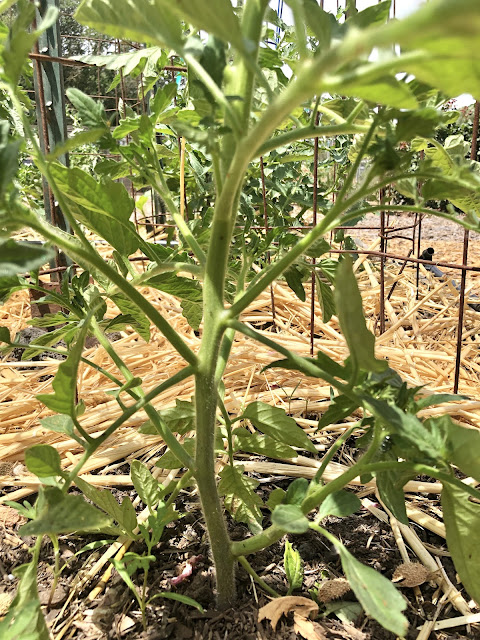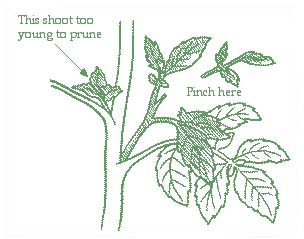
Cutting the plants back severely reduces yield, research shows

|
|
Here's a Cherokee Carbon hybrid tomato plant, in ground
about 4 weeks. At the most I'd trim off that shoot at lower
right, but not until the plant is bigger. And maybe not even then.
This is a good producer of purple-black tomatoes, and I want all the foliage -- and fruit -- I can get. (Photo: Kathy Morrison) |
Gardening has a lot of topics that provoke strong opinions among gardeners. Near the top has to be the idea of pruning tomato plants.
Over the years I've hardly pruned my plants at all. In fact, I never did until the first year I grew the hardy and prolific Juliet tomato. I was complaining to a friend that this plant was trying to take over the entire tomato bed, and she replied, "Well you know, you can prune them."
Since then, Juliet gets an occasional haircut, but the trims come only along the bottom. And that holds true for any other plant that aims to send rampant shoots across the garden.
But prune from the top? Horrors! A fellow community gardener asked me about that just today. And why would I want to cut off the growing tip of my plants? When the heat is coming and they need all the foliage they can get?
Some community gardeners do prune extensively, to a stake or a string, and then put shade cloth over the whole area to keep the tomatoes from being scorched. This seems to me like more work and less tomatoes. And I found University of California information that backs me up. Quoting here from the Integrated Pest Management website :
"Pruning your tomatoes
"Pruning is not always necessary. However, when pruning your tomatoes, remember these main points:
"Plants with two or more stems produce more tomatoes with better foliage protection from the sun than plants with one stem. However, tomatoes pruned to one leader will bear earlier but with less yield overall. Choose the stems you want to keep and pinch out the others as they develop. A dense leaf canopy may reduce the incidence of black mold and cracking but may increase the incidence of other fruit molds such as gray mold.

"Before removing suckers or side shoots on a tomato plant, wait until two leaves develop and pinch above them." (See graphic at right for illustration.)
This science-based information likely won't change the mind of anyone accustomed to pruning. Earlier tomatoes but less yield? No, I'll stick with my full-foliaged plants, thanks very much, and enjoy my crop when it does finally come in.
Comments
0 comments have been posted.Sacramento Digs Gardening to your inbox.
Sites We Like
Garden Checklist for week of July 21
Your garden needs you!
* Keep your vegetable garden watered, mulched and weeded. Water before 8 a.m. to reduce the chance of fungal infection and to conserve moisture.
* Feed vegetable plants bone meal, rock phosphate or other fertilizers high in phosphate to stimulate more blooms and fruiting. (But wait until daily high temperatures drop out of the 100s.)
* Don’t let tomatoes wilt or dry out completely. Give tomatoes a deep watering two to three times a week.
* Harvest vegetables promptly to encourage plants to produce more. Squash especially tends to grow rapidly in hot weather. Keep an eye on zucchini.
* Pinch back chrysanthemums for bushy plants and more flowers in September.
* Remove spent flowers from roses, daylilies and other bloomers as they finish flowering.
* Pinch off blooms from basil so the plant will grow more leaves.
* Cut back lavender after flowering to promote a second bloom.
* It's not too late to add a splash of color. Plant petunias, snapdragons, zinnias and marigolds.
* From seed, plant corn, pumpkins, radishes, winter squash and sunflowers.